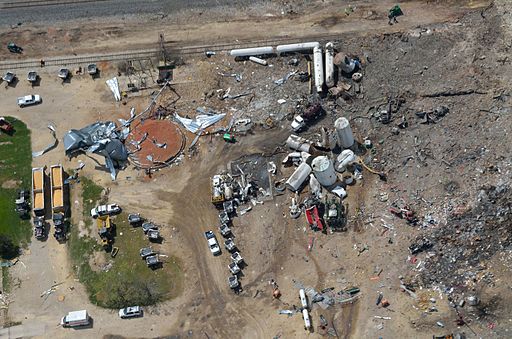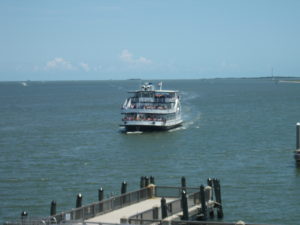That headline is a quote from Mayor Tommy Muska of the town of West, Texas, in the Dallas Morning News of November 21, regarding the Trump administration’s rescission of U.S. Environmental Protection Agency standards for disaster prevention in chemical facilities, issued that day.

So much news passes under the bridge in one month these days that readers can be forgiven if they do not immediately recall what happened in West on April 17, 2013, but my guess is that many do. Or they may if I nudge them by noting that the West Fertilizer Company suffered an explosion in a storage facility at the edge of this small city of 2,880. The explosion resulted from the combustion of ammonium nitrate, a common ingredient in fertilizer, which is notorious for its chemical instability. Still, the facility had been there since the 1960s, but West had over the years allowed a middle school, an apartment building (which was destroyed), a nursing home, and other structures to be built nearby. When the explosion occurred, 160 people were injured, 14 first responders (mostly firefighters) were killed, and one elderly man died of a heart attack as the nursing home was evacuated. All that triggered a bit of soul searching about loose regulations at all levels of government regarding the operation of such facilities, their disproportionate environmental impact on vulnerable populations, and how better to prevent future disasters.
One year later, in May 2014, I wrote in this blog about West following my own involvement on an expert panel for the federal Chemical Safety Board, which held a hearing in West on the anniversary of the disaster. I raised some pertinent questions about Texas chemical and fire safety regulation that were of interest to the board.
In the meantime, however, moves were afoot in the Obama administration to respond to the larger questions of chemical facility accidents. According to Earthjustice, an environmental advocacy group, in the decade up to the West accident the U.S. had experienced 2,200 chemical accidents at hazardous facilities, two-thirds of which caused reported harm, including 59 deaths and more than 17,000 people injured, hospitalized, or seeking medical care. As a result, President Obama signed on August 1, 2013, Executive Order 13650, “Improving Chemical Facility Safety and Security,” which set in motion a rule-making procedure at the U.S. EPA. By July 31, 2013, EPA issued a Risk Management Program request for information in the Federal Register, proposed new rules on March 14, 2016, and finalized the new rule, known for short as the Chemical Disaster Rule, on January 13, 2017, with one week remaining before President Trump took office.
The final rule is a bit complex, using 112 pages of the Federal Register, but among other items specifically required a “root cause analysis” as part of an incident investigation to determine what “could have reasonably resulted in a catastrophic release.” It would also require compliance audits after reported incidents and required all facilities with certain processes to conduct annual notification exercises to ensure that emergency contact information was complete. The overall idea was to improve effective coordination with local emergency responders. One problem that caused fatalities in West was a lack of firefighter awareness of the precise contents and dangers of the facility that exploded. Thus, the requirements in the rule for field and tabletop exercises. Finally, the rule aimed to enhance the availability of information about chemical hazards in these facilities including sharing such information with local emergency planning committees.
The rest is almost entirely predictable. With little grasp of public policy but considerable animus toward anything with Obama’s name on it, Trump put his appointees to work undoing his legacy. That included action by then EPA Administrator Scott Pruitt on March 16, 2017, in response to an industry-sponsored petition, to announce a 90-day stay of the Obama-era rules, followed by an extension to 20 months shortly thereafter. In the meantime, Louisiana and 10 other states, including Texas, petitioned for reconsideration of the Obama rules. The delay would last until February 19, 2019. However, the U.S. Court of Appeals for the District of Columbia, responding to a petition from environmental groups, vacated the Trump rulemaking. But now we have a final rule from the Trump EPA officially rescinding the Chemical Disaster Rule.
The public information aspect of the rule became a target, with the Trump administration claiming it was responding to homeland security and emergency management experts who feared that such information would become a target for terrorists. However, it would seem to me that far more people have been affected by routine chemical accidents than by any terrorist incidents at such facilities. The U.S. EPA also noted that the rules would not have prevented the accident at West because it was ultimately determined to have been caused by arson. It is worth noting, however, that most of the first responder fatalities in that incident were more credibly the result of a lack of training and information on the potential explosiveness of the materials involved, which might have prompted greater caution and different tactics by firefighters. And none of this answers the questions I raised in my 2014 blog post about land-use practices and limitations on fire safety codes in Texas.
So, back to Mayor Muska, who is reportedly disappointed with the outcome, and for good reason. His town has to live with the results of the 2013 explosion, which decimated the volunteer firefighter staff and obliterated a local business (and employer). Muska was mayor when the disaster happened and is now serving his fifth term. I think it is worth sharing the comments he made in the final two paragraphs of the Dallas Morning News story:
“The American people and American politicians, they have a short memory,” Muska said. “They’re going to say everything is fine, and every few years something like this is going to happen again, and ‘Oh, yeah, we need to look at this again.’
“We’re yesterday’s news. It’s not on anybody’s minds as it was in ’13 and ’14.”
Jim Schwab

